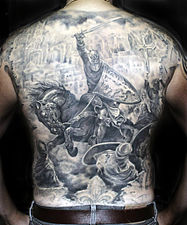
A tattoo is a form of body modification made by inserting tattoo ink, dyes, and/or pigments, either indelible or temporary, into the dermis layer of the skin to form a design. Tattoo artists create these designs using several tattooing processes and techniques, including hand-tapped traditional tattoos and modern tattoo machines. The history of tattooing goes back to Neolithic times, practiced across the globe by many cultures, and the symbolism and impact of tattoos varies in different places and cultures.

Scarification involves scratching, etching, burning/branding, or superficially cutting designs, pictures, or words into the skin as a permanent body modification or body art. The body modification can take roughly 6–12 months to heal. In the process of body scarification, scars are purposely formed by cutting or branding the skin by various methods. Scarification is sometimes called cicatrization.
Irezumi is the Japanese word for tattoo, and is used in English to refer to a distinctive style of Japanese tattooing, though it is also used as a blanket term to describe a number of tattoo styles originating in Japan, including tattooing traditions from both the Ainu people and the Ryukyuan Kingdom.

Adinkra are symbols from Ghana that represent concepts or aphorisms. Adinkra are used extensively in fabrics, logos and pottery. They are incorporated into walls and other architectural features. Adinkra symbols appear on some traditional Akan goldweights. The symbols are also carved on stools for domestic and ritual use. Tourism has led to new departures in the use of symbols in items such as T-shirts and jewellery.

Tattooing has been practiced across the globe since at least Neolithic times, as evidenced by mummified preserved skin, ancient art and the archaeological record. Both ancient art and archaeological finds of possible tattoo tools suggest tattooing was practiced by the Upper Paleolithic period in Europe. However, direct evidence for tattooing on mummified human skin extends only to the 4th millennium BC. The oldest discovery of tattooed human skin to date is found on the body of Ötzi the Iceman, dating to between 3370 and 3100 BC. Other tattooed mummies have been recovered from at least 49 archaeological sites, including locations in Greenland, Alaska, Siberia, Mongolia, western China, Egypt, Sudan, the Philippines and the Andes. These include Amunet, Priestess of the Goddess Hathor from ancient Egypt, multiple mummies from Siberia including the Pazyryk culture of Russia and from several cultures throughout Pre-Columbian South America.

Sankofa is a word in the Twi language of Ghana meaning “to retrieve" and also refers to the Bono Adinkra symbol represented either with a stylized heart shape or by a bird with its head turned backwards while its feet face forward carrying a precious egg in its mouth. Sankofa is often associated with the proverb, “Se wo were fi na wosankofa a yenkyi," which translates as: "It is not wrong to go back for that which you have forgotten."

Black-and-gray is a style of tattooing that uses only black ink in varying shades. This tattooing style is thought to have originated from prisons in the 1970s and 1980s and was later popularized in tattoo parlors.
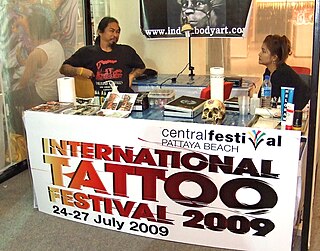
A tattoo convention is a meeting and exhibition for tattoo practitioners and enthusiasts from different shops and areas, as well as anyone who wishes to see the world of tattooing up close.
Greg Kulz is an American tattoo artist. He is based in San Francisco, California.
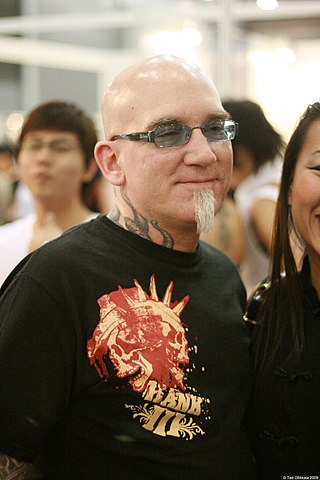
Bob Tyrrell is an American tattoo artist. He is known for his black-and-gray tattooing style.
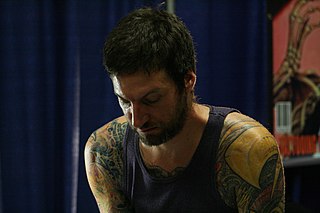
Guy Aitchison is an American tattoo artist and painter. He was featured on the tattoo reality television shows LA Ink and Tattoo Wars.

The Peʻa is the popular name of the traditional male tatau (tattoo) of Samoa, also known as the malofie. It is a common mistake for people to refer to the pe'a as sogaimiti, because sogaimiti refers to the man with the pe'a and not the pe'a itself. It covers the body from the middle of the back to the knees, and consists of heavy black lines, arrows, and dots.
Mark Mahoney is an American tattoo artist. He is considered as the founding father of black and grey art with a single needle.
The New York Tattoo Museum was a museum located at 203 Old Town Road in Staten Island's Old Town neighborhood above Dozer's shop. It was reported to be the first tattoo museum to open in New York City and housed mannequins displaying tattoo techniques, and other items from Dozer's collection. As of 2014, the museum was reported to have relocated to Medford, New York. and by 2017 it was reported to have closed.
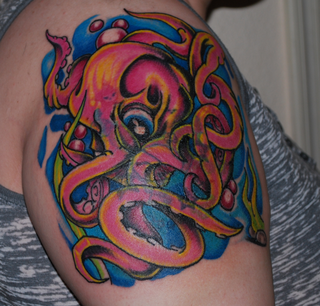
New school is a tattooing style originating as early as the 1970s and influenced by some features of old school tattooing in the United States. The style is often characterized by the use of heavy outlines, vivid colors, and exaggerated depictions of the subject. New school also represents a transition towards openness in the sharing of techniques in tattooing.

Chinese calligraphy tattoos are tattoos of Chinese characters in a calligraphic style. Today, Chinese calligraphy tattoos can be found worldwide.
Tom Riley (1870-?) was a prominent English tattoo artist in the late 19th century and early 20th century, nicknamed "Professor". Riley's work, alongside rivals Alfred South and Sutherland MacDonald, was part of establishing an English style of tattooing.

Horiyasu is a Japanese tattooist, specializing in Irezumi. He is one of the most respected contemporary tattooists in Japan.

Batok, batek, patik, batik, or buri, among other names, are general terms for indigenous tattoos of the Philippines. Tattooing on both sexes was practiced by almost all ethnic groups of the Philippine Islands during the pre-colonial era. Like other Austronesian groups, these tattoos were made traditionally with hafted tools tapped with a length of wood. Each ethnic group had specific terms and designs for tattoos, which are also often the same designs used in other art forms and decorations such as pottery and weaving. Tattoos range from being restricted only to certain parts of the body to covering the entire body. Tattoos were symbols of tribal identity and kinship, as well as bravery, beauty, and social or wealth status.

Bert Grimm was an American tattoo artist considered the "grandfather of old school". Grimm's work contributed to the development and popularity of the American Traditional tattoo style. He tattooed Bonnie and Clyde and Pretty Boy Floyd, among others.





